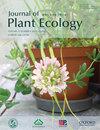温带荒漠典型短命植物——黄牡丹对积雪变化的生长响应
IF 3.9
2区 环境科学与生态学
Q2 ECOLOGY
引用次数: 0
摘要
温带荒漠生态系统积雪变化影响植物多样性、丰富度和分布。这些生态系统中草本植物的生长和分布与积雪深度密切相关,由于旱季缺水,积雪深度是生长期间最重要的水资源。然而,对冬季积雪变化的响应尚不清楚。本研究旨在探讨积雪变化对草本植物根系生长的影响。研究了古尔班通古特沙漠冬季4种积雪深度处理下典型的沙漠短生植物褐花Erodium oxyrrhinchum的生长情况。4种处理分别为除雪(−S)、环境雪、双重雪(+S)和三重雪(+2S)。雪深的增加增加了草本植物的丰度和生长率。它还提高了这些植物的生物量(包括总生物量和单株生物量)。随着雪量的增加,冬青叶面积(LA)显著增加,而叶片干物质含量(LDMC)呈相反趋势。研究表明,植物的地上部分比地下部分对雪的变化更敏感。积雪变化对根系形态也有影响。除雪导致侧根增多,而加雪促进主根伸长以吸收水分和养分。这些结果解释了冬季积雪深度的变化如何改变温带荒漠生态系统生长期的植物生长、群落结构和生态系统功能。本文章由计算机程序翻译,如有差异,请以英文原文为准。
Typical Ephemeral Plant -Erodium oxyrrhinchum: Growth Response to Snow Change in Temperate Desert, Northwest China
Snow cover changes in temperate desert ecosystems influence plant diversity, richness, and distribution. The growth and distribution of herbaceous plants in these ecosystems are closely related to snow-cover depth, the most important water resource during the growth period due to water shortage during the dry season. However, the response to snow cover change in winter remains unclear. The present investigation was undertaken to examine the influence of snow cover change on the root growth of herbaceous species. The growth of desert typical ephemeral species, Erodium oxyrrhinchum was examined in Gurbantunggut Desert with four snow cover depth treatments in winter. The four treatments were snow removal (−S), ambient snow, double snow (+S), and triple snow (+2S). The snow depth addition increased the abundance and growth rate of herbaceous plants. It also enhanced the biomass (including total and individual biomass) of these plants. The leaf area (LA) of E. oxyrrhinchum increased significantly with snow addition, and the leaf dry matter content (LDMC) had an opposite trend. The study showed that the above-ground section of the plant was more sensitive to snow change than the underground. Snow change also influenced the root morphology. Snow remove resulted in the emergence of more lateral root, whereas snow addition promoted the elongation of the main root for water and nutrient absorption. These results explain how changes in winter snow cover depth alter plant growth, community structure, and ecosystem function during the growing period in temperate desert ecosystems.
求助全文
通过发布文献求助,成功后即可免费获取论文全文。
去求助
来源期刊

Journal of Plant Ecology
生物-植物科学
CiteScore
4.60
自引率
18.50%
发文量
134
审稿时长
3 months
期刊介绍:
Journal of Plant Ecology (JPE) serves as an important medium for ecologists to present research findings and discuss challenging issues in the broad field of plants and their interactions with biotic and abiotic environment. The JPE will cover all aspects of plant ecology, including plant ecophysiology, population ecology, community ecology, ecosystem ecology and landscape ecology as well as conservation ecology, evolutionary ecology, and theoretical ecology.
 求助内容:
求助内容: 应助结果提醒方式:
应助结果提醒方式:


